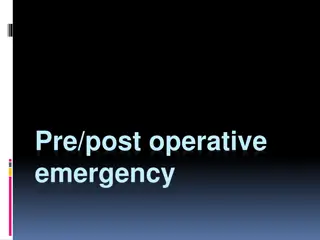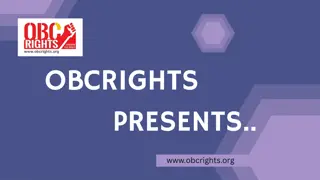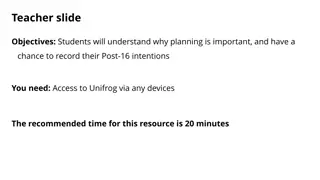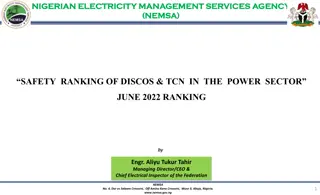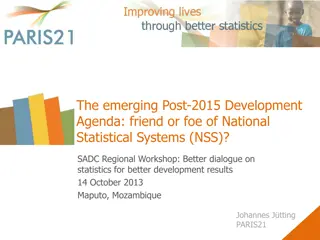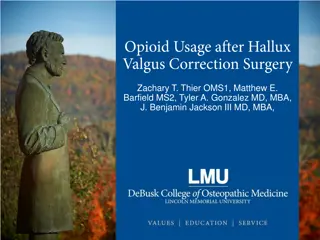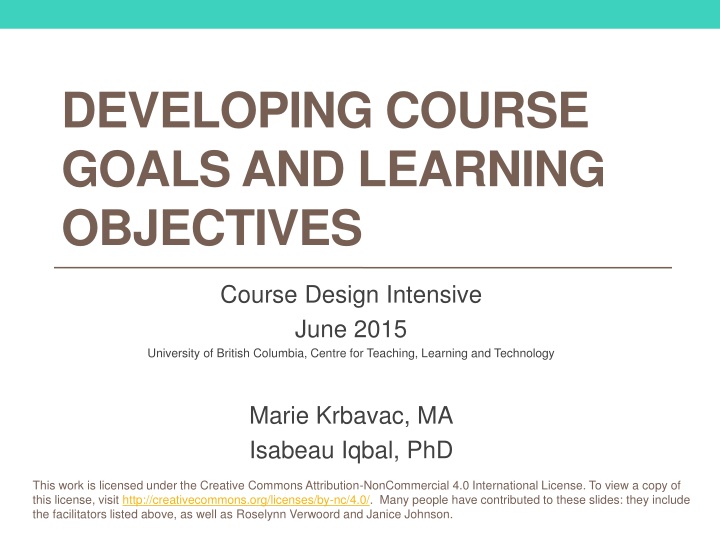
Effective Course Design with Learning Objectives - University Course Development Guide
Learn how to develop course goals and learning objectives effectively through a learning-centered approach. Explore techniques such as DACUM process, Bloom's Taxonomy, and integrated course design for creating impactful learning experiences. Drive student success by aligning course content with clear educational outcomes.
Download Presentation

Please find below an Image/Link to download the presentation.
The content on the website is provided AS IS for your information and personal use only. It may not be sold, licensed, or shared on other websites without obtaining consent from the author. If you encounter any issues during the download, it is possible that the publisher has removed the file from their server.
You are allowed to download the files provided on this website for personal or commercial use, subject to the condition that they are used lawfully. All files are the property of their respective owners.
The content on the website is provided AS IS for your information and personal use only. It may not be sold, licensed, or shared on other websites without obtaining consent from the author.
E N D
Presentation Transcript
DEVELOPING COURSE GOALS AND LEARNING OBJECTIVES Course Design Intensive June 2015 University of British Columbia, Centre for Teaching, Learning and Technology Marie Krbavac, MA Isabeau Iqbal, PhD This work is licensed under the Creative Commons Attribution-NonCommercial 4.0 International License. To view a copy of this license, visit http://creativecommons.org/licenses/by-nc/4.0/. Many people have contributed to these slides: they include the facilitators listed above, as well as Roselynn Verwoord and Janice Johnson.
2 June 1, 2015 Learning-centered approach to integrated course design (Fink, 2013) The heart of this approach is to decide what students can and should learn in relation to the subject and then figure out how learning can be facilitated.
3 June 1, 2015 A model of integrated course design (Fink, 2013)
4 June 1, 2015 Session learning objectives By the end of this session, you will be able to: Explain the DACUM process for course design Articulate the difference between a course goal and learning objective Create 2-3 course goals for your course Write at least two learning-centred learning objectives using Bloom s Taxonomy of Educational Objectives
5 June 1, 2015 DACUM Developing a Curriculum Process for developing course content/curriculum Have you heard of this? What do you know about it?
6 June 1, 2015 Brainstorm Organize Reflect Consolidate
7 June 1, 2015 Students will be able to (SWBAT) drive a car effectively and safely Form a small group (four people) Individually brainstorm everything you can think of that relates to the topic Write each idea on a separate sticky 2 x 2 note Stick them randomly on table/wall
8 June 1, 2015 SWBAT: drive a car effectively and safely Working in your group, organize the sticky notes into clusters of related items. Remove duplicates
9 June 1, 2015 SWBAT: drive a car effectively and safely Once you agree on your clusters, develop a general statement/goal that relates to each cluster Consider: What is this cluster about? E.g., safety? Mechanics? Write each goal on a large sticky note Set your chart up as a DACUM (on flipchart paper)
10 June 1, 2015 SWBAT: drive a car effectively and safely Within each course statement/goal (the large stickies), organize your learning topics/concepts (the small stickies) in some logical fashion Simple -> complex General -> specific, or vice versa Chronological Concrete -> abstract, or vice versa
11 June 1, 2015 DACUM chart: Two components Course goals Learning objectives
12 June 1, 2015 Course Goals & Learning Objectives Course goals: General statements (typically 4-5) that describe what you want your student to know/do as a result of taking this course Should be consistent with program/Faculty goals and the institutional mission Sometimes written from the instructor s point of view
13 June 1, 2015 Cross-cultural dance studies course goals (example) Course Goals: To appreciate dance as a cultural practice that occurs universally and with infinite variety To recognize, reflect upon and be able to articulate the essential components of dance movement To understand that dance is a form of human expression as well as a means of communication (Source: http://www.washington.edu/students/icd/S/dance/250bcoop.html)
14 June 1, 2015 Computer programming course goals (example) Course Goals: To teach basic programming-in-the-small abilities and concepts, with procedural/functional abstraction and simple built-in datatype manipulation the highlights. To teach basic abilities of writing, executing, and debugging programs. (Source: http://www.cs.washington.edu/education/syllabi/142.html)
15 June 1, 2015 Learning objectives Learning objectives articulate the knowledge, skills and/or attitudes you want students to acquire by the end of the class or after completing a specific assignment Describe an intended result of instruction, rather than the process of instruction itself
16 June 1, 2015 Course Goals Learning Objectives General statements (typically 4-5) that describe what you want your student to know/do as a result of taking this course. Articulates the knowledge, skills and/or attitudes the learner is expected to achieve by the end of a lesson, activity, assignment etc Elementary Spanish To develop skills that will enable you to listen, speak, read, and write in the target language at the Novice mid or high Proficiency Level. 1.1 use listening and speaking skills to cope with subject areas such as articles of clothing, naming of basic objects, colors, names of family members, the weather, days of the week, months of the year, today s date and year, telling time, etc. 1.2 improve pronunciation so as to be understood by a native speaker used to dealing with foreigners. Source: http://www.baylor.edu/spanish/index.php?id=858957
17 June 1, 2015 Learning Objectives When learner achieves a series of related learning objectives, achieved a Course Goal Learning objectives often prerequisites for next level of learning/course or entry level job skills
18 June 1, 2015 Domains of learning Image: http://www.icomproductions.ca/what-we-know/
19 June 1, 2015 Writing Learning Objectives Learning Domains Cognitive knowledge, intellectual Affective attitudes, emotions Psychomotor skills, often physical
20 June 1, 2015 Different Levels of Learning Learners must be able to do/know things on lower levels before can do/know things at higher levels Cumulative, hierarchy Example verbs for use in DACUM/course profile chart Cheat sheet for writing learning objectives
21 June 1, 2015 Activity: Driving a car In your groups, go back to your DACUM Choose one course goal and 2-3 of its related learning objectives Using Bloom s taxonomy, write out 2 or 3 learning objectives (on post-its)
22 June 1, 2015 Learning objectives Learning objectives articulate the knowledge, skills and/or attitudes you want students to acquire by the end of the class or after completing a specific assignment What will the learners be able to do/ know/feel by the end of this session?
23 June 1, 2015 Verbs to Avoid Understand Know Learn Why do we want to avoid using these? Because .Objectives should be: specific, measurable, observable, achievable, realistic, clear
24 June 1, 2015 Activity: Driving a car In your groups, go back to your DACUM Choose one course goal and 2-3 of its related learning objectives Using Bloom s taxonomy, write out 2 or 3 learning objectives (on post-its) Learning centered, specific, measurable, observable, achievable, realistic, clear
25 June 1, 2015 Using Course Goals & Learning Objectives What do we do with learning objectives (as instructors)? Plan Teach Evaluate Once we have course goals & learning objectives, have foundation to write lesson plans, select teaching strategies and learning activities, consider assessment
26 June 1, 2015 Process Considerations Each learning objective = approx. 30-60 mins of instruction Recommend keeping a course design journal Log what changes you made and why Each time use DACUM, add/subtract elements
27 June 1, 2015 Choices for Applying Your Learning If you are building a course from scratch Start working on your course profile/ DACUM If you are re-working a course, & you do not have explicit course goals & learning objectives for your course Start working on your course profile/ DACUM If you are re-working a course, & you have explicit course goals & learning objectives for your course Re-visit them brainstorm, cluster, make changes, reword
28 June 1, 2015 Feedback from a Colleague (10 mins total) In pairs, take turns sharing your DACUM. Discuss 1-2 challenges (does your colleague have ideas that can assist you with resolving these challenges?) Individually determine the immediate next steps for progressing with your DACUM: What do you commit to doing before Wednesday, June 3rd at 9 am?! Share the above with your colleague (colleague, please make note so you can check in next day!)


